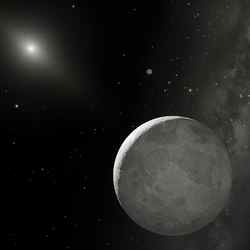
An artist’s illustration of Xena with its moon. Image credit: NASA Click to enlarge
The powerful Hubble Space Telescope has finally been brought to bear on the newly discovered 10th planet (aka Xena), to help answer the question: is it really bigger than Pluto? Hubble is the only instrument that can make an actual visible light observation of Xena’s diameter. Hubble found that Xena is is about 2400 km (1,490 miles) across, which makes it only 113 km (70 miles) larger than Pluto. This makes the 10th planet unusually bright, probably covered in brilliant white methane snow.
For the first time, NASA’s Hubble Space Telescope has seen distinctly the “tenth planet,” currently nicknamed “Xena,” and has found that it is only slightly larger than Pluto.
Though previous ground-based observations suggested that Xena’s diameter was about 30 percent greater than Pluto, Hubble observations taken Dec. 9 and 10, 2005, showed Xena’s diameter as 1,490 miles (with an uncertainty of 60 miles). Pluto’s diameter, as measured by Hubble, is 1,422 miles.
“Hubble is the only telescope capable of getting a clean visible-light measurement of the actual diameter of Xena,” said Mike Brown, planetary scientist at the California Institute of Technology in Pasadena, Calif. Brown’s research team discovered Xena, officially cataloged as 2003 UB313, and its results have been accepted for publication in the Astrophysical Journal.
Only a handful of images were required to determine Xena’s diameter. Located 10 billion miles from Earth with a diameter a little more than half the width of the United States, the object is 1.5 pixels across in Hubble’s view. That’s enough to make a precise size measurement.
Because Xena is smaller than previously thought, but comparatively bright, it must be one of the most reflective objects in the solar system. The only object more reflective is Enceladus, a geologically active moon of Saturn whose surface is continuously recoated with highly reflective ice by active geysers.
Xena’s bright reflectivity is possibly due to fresh methane frost on its surface. The object may have had an atmosphere when it was closer to the sun, but as it moved to its current location farther away this atmosphere would have “frozen out,” settling on the surface as frost.
Another possibility is that Xena leaks methane gas continuously from its warmer interior. When this methane reaches the cold surface, it immediately freezes solid, covering craters and other features to make it uniformly bright to Hubble’s telescopic eye.
Xena’s takes about 560 years to orbit the sun, and it is now very close to aphelion (the point on its orbit that is farthest from the sun).Brown next plans to use Hubble and other telescopes to study other recently discovered Kuiper Belt objects that are almost as large as Pluto and Xena. The Kuiper Belt is a vast ring of primordial icy comets and larger bodies encircling Neptune’s orbit.
Finding that the largest known Kuiper Belt object is a virtual twin to Pluto may only further complicate the debate about whether to categorize the large icy worlds that populate the belt as planets. If Pluto were considered to be the minimum size for a planet, then Xena would fulfill this criterion, too. In time, the International Astronomical Union will designate the official name.
The Hubble Space Telescope is an international cooperative project between NASA and the European Space Agency. The Space Telescope Science Institute in Baltimore conducts Hubble science operations. The Institute is operated for NASA by the Association of Universities for Research in Astronomy, Inc., Washington
For electronic images and more Hubble news, visit: http://www.nasa.gov/hubble
Original Source: NASA News Release
Update, Pluto is no longer a planet. Why is Pluto not a planet?
